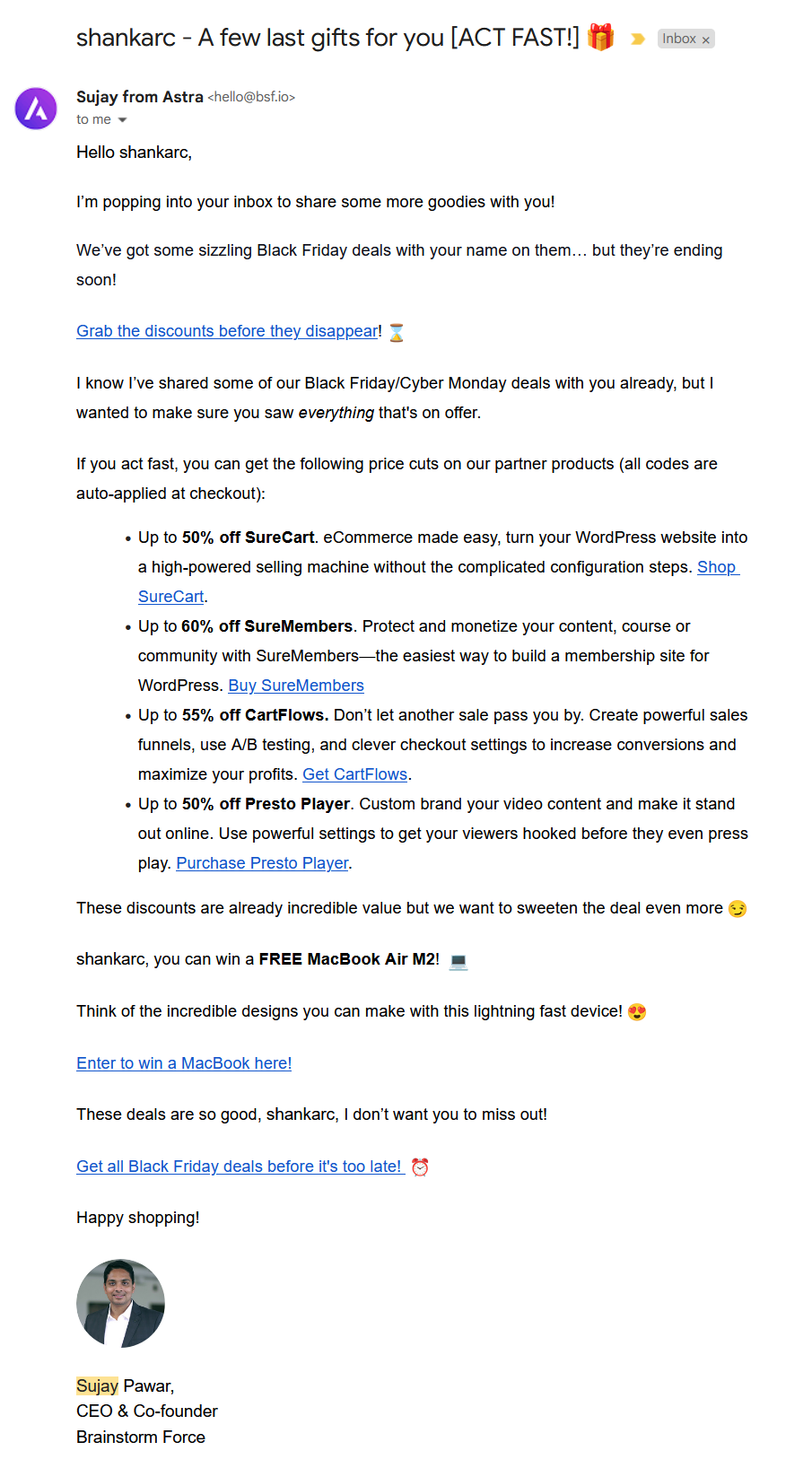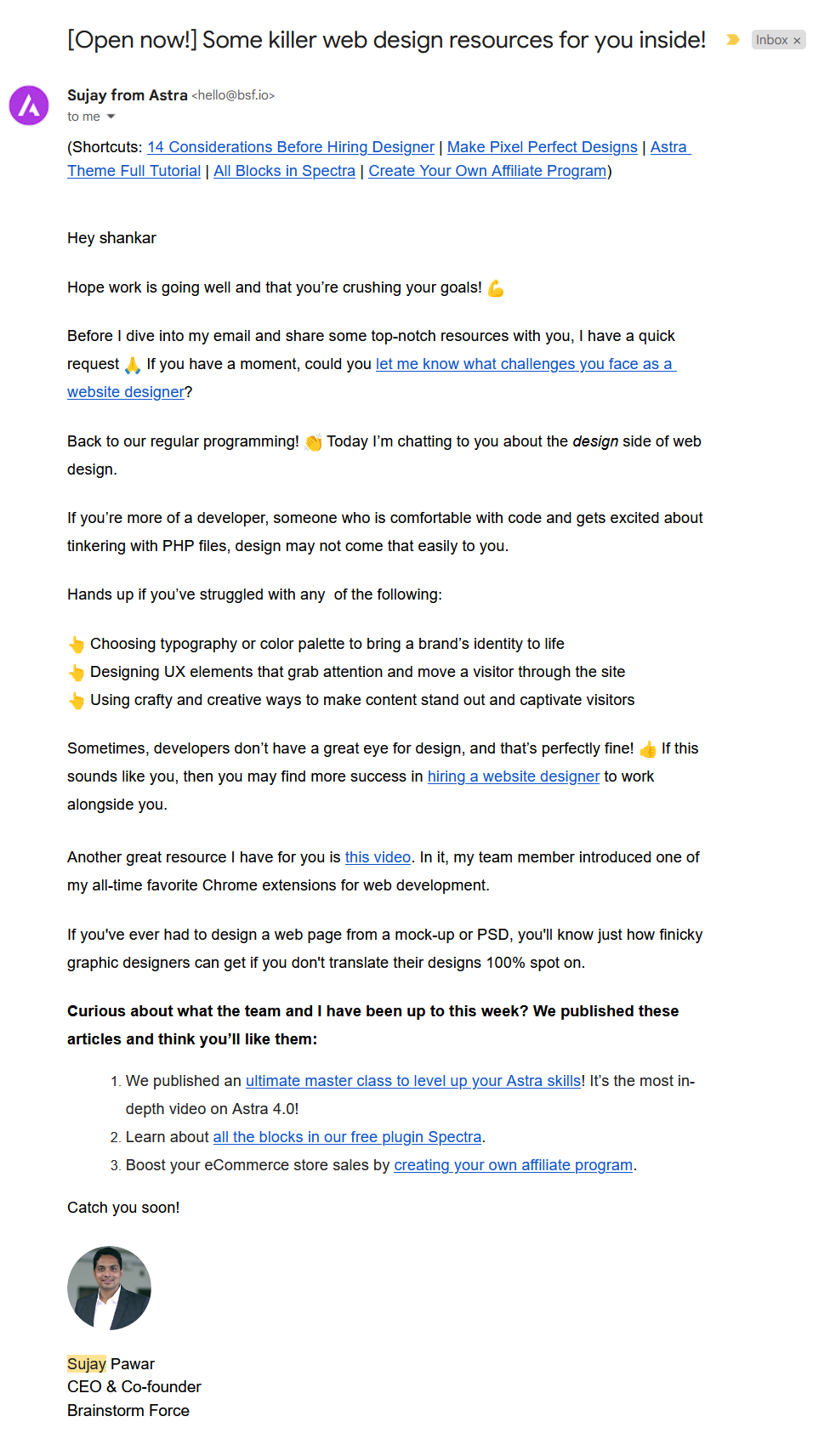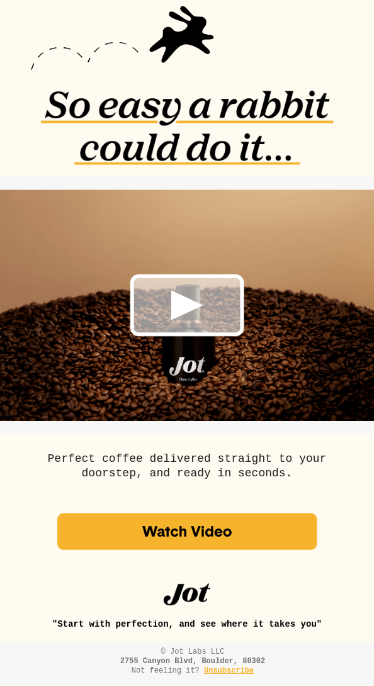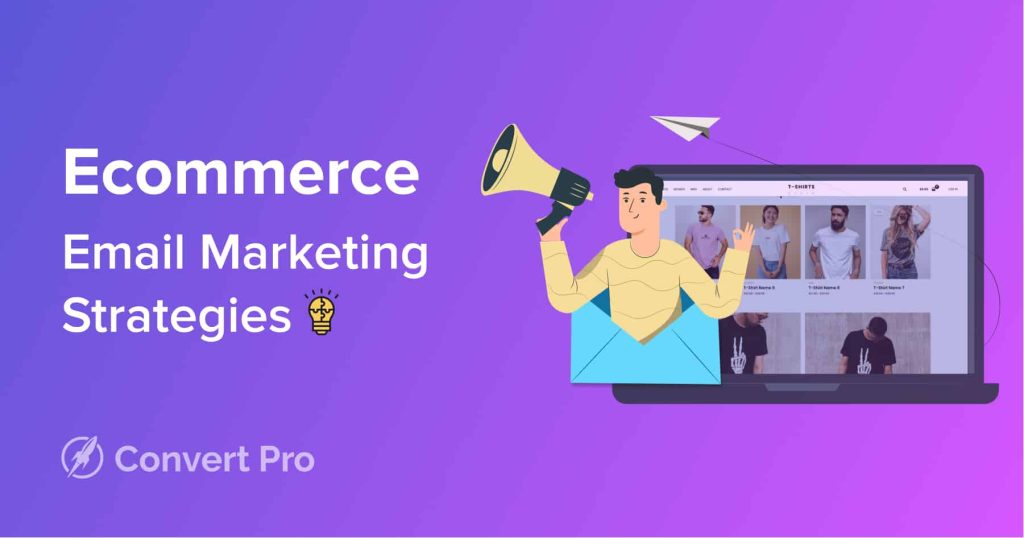Email marketing is a vital channel for engaging with visitors and encouraging them to become repeat customers.
Done right, email is cost-effective and offers a targeted approach to building a loyal audience.
It’s also measurable so you can assess how well each email performs and refine them as you go.
Of all the marketing options available to you, email is the easiest to get into and offers the highest potential for engagement and profit.
That’s why it’s so popular!
Launching the first email marketing campaign for your online business can seem intimidating at first but we’re here to help.
If you’re looking for tips on how to grow your brand with eCommerce email marketing, you’ve come to the right place!
In this article, we will look closely at nine proven email marketing strategies that can help you grow your eCommerce business.
- Why is email marketing so important in eCommerce?
- Email marketing ideas for eCommerce
- 1. Establish a strong email eCommerce marketing strategy
- 2. Grow your email list
- 3. Create attractive email newsletters
- 4. Send targeted emails to specific customers
- 5. Use social media to promote email campaigns
- 6. Ask for customer reviews
- 7. Experiment with different types of content
- 8. Test and track your email marketing campaigns
- 9. Continually improve your email marketing campaigns
- Conclusion
Why is email marketing so important in eCommerce?
Email is an effective way to communicate and engage with your audience. It’s cheap, easy to do and can be largely automated.
It can also be personal, adding that essential element that helps create profitable relationships.
Here are the most common types of eCommerce email marketing:
- Transactional emails. Includes information such as product order confirmations, payment receipts, and shipment details. With Magento 2 email templates, these transactional emails can be customized and automated, ensuring they are sent automatically to eCommerce customers, whether they’re on your mailing list or not.
- Promotional emails. Businesses use this type of email to promote special offers like a Black Friday sale, to increase click-through rates (CTRs) and convert qualified leads.
- Re-engagement emails. Often called lifecycle emails, this type of email asks buyers to perform a specific action based on their last activity. For example, abandoned cart emails remind people to complete a purchase.
There are a number of tangible benefits to having an effective eCommerce email marketing strategy:
- Nurturing leads. Email marketing can be very effective at lead generation. It lets you send targeted messages to specific segments based on interests, demographics and user behaviors.
- Retargeting inactive customers. eCommerce email marketing helps re-engage customers who haven’t been interacting with your products or services. With better customer segmentation, you can send lifecycle emails that encourage shoppers to take relevant action.
- Upselling and cross-selling products. You can use transactional emails to incorporate upselling and cross-selling strategies. For instance, include a digital catalog with related product suggestions in order confirmation emails based on customers’ preference data.
- Increasing sales. Email marketing enables you to send special offers and relevant product information while encouraging customers to purchase.
- Improving brand reputation. An eCommerce email marketing strategy helps establish a good reputation through consistent branding efforts.
- Easier tracking. Automate email marketing and track your campaigns using analytics tools. This helps you measure marketing performance and learn what type of email content resonates with your audience.
Email marketing ideas for eCommerce
Email marketing is one of the most effective channels to engage with existing customers, reach new prospects, and build a positive brand image.
To help you avoid common email marketing mistakes, let’s discuss nine proven ways to grow your eCommerce brand using email marketing.
1. Establish a strong email eCommerce marketing strategy
Creating a solid eCommerce email marketing strategy helps align emails with your business objectives and communicate your brand’s value proposition.
Do it right and you’ll create solid customer relationships and better sales opportunities. Both can result in extra profit!
That all sounds very formal, but a strategy helps you plan what you’re going to be doing, what emails you need to do and how you’ll send them.
To start email marketing, use a reliable business email service from providers like Hostinger.
Business email is a step up from standard and affordable VPS hosting and has the reliability to deliver every email on time, every time. They are also less likely to be blacklisted by spam platforms.
You can be notified every time an email is opened.
Some providers also let you use custom email templates so you don’t even have to design your emails.
Once your business email account is set up, plan your email campaigns by following these steps:
Research your target audience
Define a specific target audience based on your niche and products. If you already have a defined target audience, use what you know about them to direct your strategy towards converting them.
If you want to experiment with new audience groups, utilize tools like Google Trends. It enables you to analyze and compare keywords to determine what people are searching for.
If you have yet to define who your target audience is, tools like Google Analytics and Semrush are excellent for collecting demographic data such as age, gender, location, behaviors, and interests.
These tools are also useful for assessing competitors’ performance.
Create customer segmentation
Once you have enough data on the target audience, categorize them into segments to create more personalized messages for each group.
Let’s say your email campaign aims to increase sales from existing customer groups. You can divide them into sub-groups, like active users and inactive users or frequent customers and infrequent customers.
This helps you improve the effectiveness of your email marketing strategy by enabling you to create emails specifically for each reader.
Define measurable goals
Set specific indicators to stay on track with your business objectives and evaluate the success of your campaign.
Let’s use the earlier example for the email marketing goal – to increase sales from existing customer groups.
The next step is to define how you will measure the goal for this campaign period – for example, by percentage growth or the total number of sales.
SMART goals can be useful to create measurable objectives for your email campaigns.
Visualize your email campaign
We eat and we buy with our eyes. That means any email you send has to be visually appealing.
Your first priority is to ensure your email templates fit your brand. Second, they should include a clear structure so a reader can easily see what’s inside and follow the story.
You could also sweeten the deal by offering time-sensitive discounts to create a sense of urgency.
The main aim is to personalize your emails so they speak directly to the segment you’re targeting. Design plays an important role in that.
Allocate time to craft the right messaging
Once you have the email template and creative visuals ready, it’s time to write the email content.
Aside from building a trustworthy brand, the aim of email marketing is to generate sales for your eCommerce business.
For that, write catchy copy encouraging readers to take action, like pre-order a product or sign up for a newsletter.
If you don’t have that kind of skill, we recommend hiring a freelancer or copywriter that does.
Any investment here could be repaid many times over with compelling email copy!

2. Grow your email list
An email list contains the names and contact details of prospects and customers who want to receive communications from a business.
Growing this list is essential for communicating with existing customers and getting new email subscribers. The larger your list, the wider the potential pool of customers.
Collecting email addresses from high-quality prospects and other sources is important.
They are the ones genuinely interested in your products and services, shown by how regularly they interact with your brand across various channels.
Without targeting quality leads, you’ll end up sending emails to low-quality prospects who won’t open them and take the desired action. This results in low CTRs and conversions, which is a waste of time and resources.
To gather relevant email and contact information:
- Add a subscription form to your website. This helps gather new leads for your mailing list. Create a subscription form with Convert Pro where users can fill in their name, contact information, and content preferences.
- Offer a chatbot on your website. A chatbot can initiate engaging conversations with website visitors. Through these conversations, chatbots can gather information such as email addresses and other relevant contact details to grow your email list.
- Use email marketing services. Email marketing automation tools like Mailchimp enable you to create pop-up and embedded forms with appealing visuals
- Create a landing page. A separate page dedicated to email subscription can give visitors a smoother user experience. Check out these landing page templates for inspiration.
- Include a call to action (CTA) in your email. Adding a clear and personalized CTA in your email encourages readers to perform a specific action in one click. Research suggests that the average CTR of email calls to action is 4.23%, higher than the average for Google Ads.
- Utilize paid ads for lead generation campaigns. You can create a Google Ads Search campaign and set a lead generation goal. The ads will appear for relevant queries, helping drive more visitors to fill in the subscription form on your website.
- Send a welcome email to new customers. A welcome email helps new customers learn more about your products and services. It’s also a great way to start building brand loyalty and set the tone for your future relationship.
3. Create attractive email newsletters
Newsletters are emails periodically sent to your subscriber list. Businesses often use them to provide the latest updates about their company and products. They might also be used to promote events and newly published articles.
You can do the same.

While newsletters can touch on multiple topics, this email marketing strategy aims to increase user engagement.
So, consider the type of content customers want to read and how your products and services can add value.
Here are some ideas to help create an effective eCommerce newsletter:
- Use email marketing software. Having the right tool lets you easily create professional-looking newsletters. For example, AI-based software like Sendinblue has an analytics feature that helps with performance tracking.
- Prepare segmented newsletter email lists. Ensure the people on your list have consented to receive email newsletters. Ideally, you should use double opt-in, meaning that people confirm their subscription in a separate email after signing up through a form.
- Design an email newsletter that converts. Start by creating an email subject line that grabs readers’ attention. Then, include your brand logo design, high-quality photos, engaging copy, and a CTA button. Also, pay attention to the content structure and place the most important elements above the fold. Ensure e-commerce image optimization to improve loading times and visual appeal, enhancing the overall user experience.
- Monetize your email newsletter. There are ways to make money through email newsletter subscriptions, such as via paid memberships, affiliate marketing and digital products like eBooks.
- Attract newsletter subscribers. Use lead magnets and teaser content on your eCommerce website and in order confirmation emails to attract more newsletter subscribers.
- Launch your email newsletter campaign. Preview the newsletter to check for errors before scheduling and sending your email campaign. Send the email at the best time for a higher open rate.
- Track your email newsletter metrics. Measure your email newsletter performance to determine what works and what needs improvement. Important email marketing metrics include conversion rate, bounce rate, CTR, and open rate.
To help you brainstorm ideas for creating excellent newsletters, learn how to create email newsletters that convert.
4. Send targeted emails to specific customers
Targeted email marketing can help reach audience segments with a tailored message based on particular interests and characteristics like demographics and behaviors.
This is an effective way to increase conversion rates as it feels more personal and contents are more relevant.
By understanding which type of customer suits your products, you’ll know how to provide them with the information and solutions they need.
With relevant content, the more likely they will interact with your email.
Designing a custom email for specific customers will also make them feel valued, enhancing trust in your brand.
Utilize analytics tools to gather relevant information about your target audience. As mentioned earlier, using email marketing software to incorporate the findings into your email campaigns can really help.
Typically, most email marketing tools also include a built-in A/B testing feature to measure the effectiveness of your content. That way, you can compare two versions of an email to determine which works best for conversions.
Some email marketing tools also offer a customer relationship management (CRM) feature to organize and store audience data.
5. Use social media to promote email campaigns
Social media platforms are great avenues to extend your eCommerce email marketing strategy.
Although email marketing and social media work differently, you can integrate the two channels to gain more information about potential customers.
For instance, once you conduct A/B testing on the copy of your automated emails, apply the best-performing one on your social media ads. This way, you can align the message on both channels.
Also, consider promoting your email marketing landing page on your company’s social media profiles, like Instagram and LinkedIn. You will especially like the latter as there are a lot of automation tools on LinkedIn that can save you time. Just remember to choose the right platforms based on your target audience.
Another strategy is to use paid ads, such as Twitter ads. Twitter is an excellent platform for building a customer base through word-of-mouth promotion.
Many email marketing tools and CRM software can help your online business gather customer data across platforms and store them in a database.
This offers an easier way to generate useful insights and track your email campaigns.
That may seem like overkill in the beginning but you never know how much you’ll grow!
6. Ask for customer reviews
Customer reviews help your business and potential buyers learn how paying customers feel about your product or service.
Research shows that 45% of consumers are more likely to visit a business that responds to negative reviews.
Moreover, 84% of millennials don’t trust traditional advertising and 98% of consumers find online reviews an essential factor when making purchasing decisions.
An excellent way to gather testimonials is through email marketing. Include a customer feedback form or short survey in your marketing emails, website, and social media pages.
That way, you can gather plenty of feedback from existing consumers.
If you use a clear CTA in emails for customers to leave a review and rating on your site, they are much more likely to use them.
People will get to see that your brand genuinely listens to customer feedback to personalize experiences. Once you acquire a lot of positive testimonials, you can use them as social proof on your website and elsewhere to help increase conversion.
7. Experiment with different types of content
Knowing which content appeals to different subscriber segments is crucial in email marketing.
We recommend trialing different types of content to see which ones generate the most user interactions.
Weekly blogs, infographics, webinars, and article recommendations are great options to engage with the audience.
Pay attention to the visual elements you’re using. Compelling images can help your brand communicate marketing messages more effectively. For instance, animated images may draw readers’ attention better.
Embedding videos in emails is another excellent way to increase your content’s attractiveness. Your brand can benefit from video email marketing to deliver information about new initiatives and products.
Company introduction videos, news and events highlight videos, product demonstration videos, customer testimonial videos, and educational videos are excellent content ideas for your email marketing strategy.
In fact, 84% of consumers have been convinced to purchase after watching a brand’s video!
Here are some other advantages of embedding videos in emails:
- Videos are more engaging and help deliver valuable information to users.
- Videos are easier to understand when showcasing the value of your products and services.
- Customers can better sense your brand personality through videos, strengthening your company image.
FlexClip , a versatile online video editor, can be a valuable tool in creating compelling video content for your email marketing campaigns.
Take a look at the example below from the coffee company Jot.
Along with an eye-catching heading, it uses a high-quality video to showcase the product’s benefits.

8. Test and track your email marketing campaigns
Testing and measuring your campaign performance can unlock useful insights. Fortunately, most email marketing tools offer the ability to A/B test and track emails.
Testing helps you see how subscribers interact with your email campaigns. You can use what you find to steadily improve the email structure, copy and calls to action until you have a template you know performs well for your particular audience.
Here are some important elements to test when creating an effective email strategy:
- Subject line. Compare shorter and longer subject lines to see which one works better. You can also try a different tone of voice to identify the one your subscribers engage with most.
- Content. Experiment with content types and lengths and send them to different customer segments. Measure which type performs best and use that in future mails.
- Call to action. Use bold CTA designs to drive action. Try different colors and fonts to make them stand out.
- Delivery time. Try sending your marketing emails on different days and times to determine when the open rate and CTR are the highest.
In addition, assess your campaigns periodically. You can make a weekly or monthly tracking schedule to see whether the email marketing metrics meet your objectives.
We recommend gathering data on the following:
- Open rate. This metric shows the percentage of recipients who open your email.
- CTR. It measures how many subscribers clicked on links provided in your email.
- Conversion rate. This metric shows the percentage of people who clicked on a link in an email and performed the desired action, such as purchasing a product.
- Bounce rate. Use this metric to discover the percentage of unsuccessful email deliveries.
- Email sharing rate. This metric shows how many recipients clicked on the social share or forward button within an email.
- Spam score. Measures how many people mark your emails as spam. A high spam score indicates your audience is uninterested in receiving your offers.
- Unsubscribe rate. Businesses use this metric to measure the percentage of users who unsubscribe after opening an email.
9. Continually improve your email marketing campaigns
Once you analyze what’s working and what isn’t by testing and tracking, use those insights to enhance your email marketing efforts.
While tools can help you with automation and analytics, you will need to incorporate the data into personalized content that appeals to customers.
Go through your existing email marketing strategies by defining objectives, checking your mail list segmentation, and planning content. Then, keep measuring performance and refining your emails depending on what you find.
Conclusion
An email marketing strategy enables eCommerce businesses to communicate their brand message and send product offers through promotional content. It also helps retain customers, as well as gain new subscribers.
To help you plan the best email marketing strategy for your online store, here are nine methods you can try:
- Create a solid email marketing strategy.
- Build segmented mailing lists.
- Provide subscribers with engaging newsletters.
- Send targeted marketing emails based on the type of subscriber.
- Promote your email campaigns on multiple social media channels.
- Ask customers to give feedback for your eCommerce store.
- Try different kinds of content in your email.
- Conduct tests and regular performance tracking to measure email marketing success.
- Keep improving your campaign performance.
We hope this article helps you better plan your eCommerce email marketing campaigns. Good luck growing your brand online!


